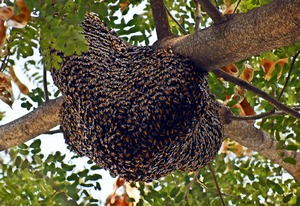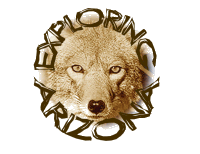Swarming

Just as new bees constantly must be produced in a colony to replace those that die, new colonies must be started from time to time because few colonies live longer than 20 years.
At the time of greatest brood producing activity every spring, the number of new bees being produced is greater than the number of bees dying of old age. This growth of population seems to start preparations for swarming. First, queen cells are built, which suggests that the queen’s powerful odor is not being passed along very well, probably due to the large size of the colony. About two weeks before the new queens come out of their cells, the old queen stops laying eggs and her body shrinks enough to allow her to fly. Then on a warm sunny day a few bees suddenly become restless and other bees respond by becoming excited too. The response quickly multiplies until thousands of bees, including the queen, come out of the hive during several minutes. About one half of the bees remain in the hive. The flying bees begin to move away from the old nest in a swarm that may measure about 30-50 feet across. They may travel as little as a few feet or as much as a quarter mile before settling on an object in a cluster. Then a few worker bees leave the swarm, apparently in search of new nest sites. After a new nest site is “chosen", the whole swarm moves to the location. The first bees to arrive begin scent fanning (see Study Print 4 for more about this). The scent is highly attractive to the other bees and they land at the entrance of the new nest, enter, and form a new cluster inside. Most of the bees then begin to make beeswax. Within a few days several combs are near completion. So long as the new nest is started early enough in the year there will be time for the bees to finish building comb and to collect and store enough food to keep them alive during the next winter. Back in the old nest a new queen comes out of one of the queen cells and kills all the other new queens. After she takes her mating flight, she begins to lay eggs. Within two or three months the colony is back to normal size.
The site for a new nest is chosen by a few worker bees called scouts. They search for hollow logs, the hollow walls of buildings and other closed-in places. When a scout has found a suitable place, it returns to the swarm and does a “dance” in a figure of 8, on the surface of the cluster. Just like food dances, this dance contains information about the direction and distance of the possible site, and possibly other information that we do not know about. How the other bees take in this information and what use they make of each message is not known. But the senses of hearing, touch, smell, and sight are probably used. After dancing a few minutes, the scout leaves to inspect the site again and then returns and repeats the dance. Scouts from different sites do different dances. The better the site the more the scout dances. This seems to make the other scouts fly off to inspect the better site. Soon all the scouts are visiting the same site and dancing the same, message, and the swarm flies off to the new nest. The scout bees fly quickly through the swarm in the right direction, again and again. It is not known if the scouts actually guide the bees by this behavior or whether the bees would go to the right place anyway by following information passed along by the scouts.
The Bees section was created with special thanks to Louis Juers (Arizona State Parks & Trails) for providing information used in this section. Additional information and digital materials were obtained from some of the following organizations. We would like to thank them for all their dedication and hard work within their profession.
|









